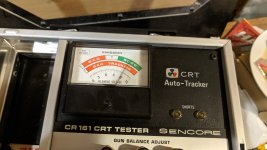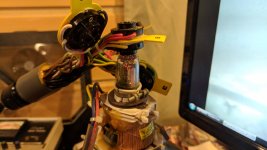techknight
Well-known member
For the heck of it, I decided to test a compact mac CRT, a 12ATY4N from I think an SE or maybe a Plus.
it had SEVERE burn-in and I kept it around just in case. So for giggles I decided to pull out my Sencore CR161 and test the tube.
Once I realized it was a 12V tube and not a 6V tube, I got better readings. It honestly actually surprised me a bit. For such severe burn in, the tube still tests strong.
The point? Well I dunno, I don't really have one. Just a wild thought. It'll make it easier for me to pick and choose CRTs I guess, or aid in a troubleshooting process. But it goes to show you that even though a tube has severe burn in, don't write it off just yet!
The CRT tester also does a "life test" which basically estimates how much cathode material is left, or "life" in the electron gun of the tube. It cuts the filament off while continuing to test emissions. If it starts dropping like a rock instantly, the tube doesnt have much time left in this world. However if the needle stays steady, or drops very very little within 5 to 10 seconds, its got another decade or so of use left in it.


it had SEVERE burn-in and I kept it around just in case. So for giggles I decided to pull out my Sencore CR161 and test the tube.
Once I realized it was a 12V tube and not a 6V tube, I got better readings. It honestly actually surprised me a bit. For such severe burn in, the tube still tests strong.
The point? Well I dunno, I don't really have one. Just a wild thought. It'll make it easier for me to pick and choose CRTs I guess, or aid in a troubleshooting process. But it goes to show you that even though a tube has severe burn in, don't write it off just yet!
The CRT tester also does a "life test" which basically estimates how much cathode material is left, or "life" in the electron gun of the tube. It cuts the filament off while continuing to test emissions. If it starts dropping like a rock instantly, the tube doesnt have much time left in this world. However if the needle stays steady, or drops very very little within 5 to 10 seconds, its got another decade or so of use left in it.


Last edited by a moderator:
